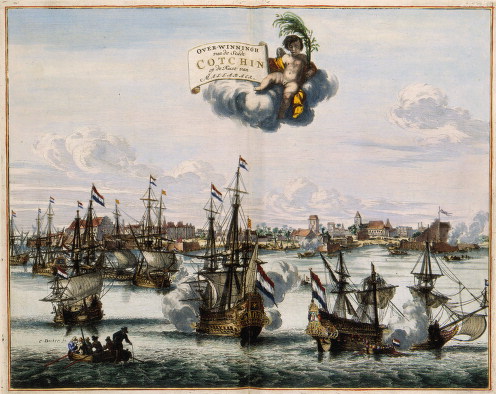The
European Overseas Expansion
 What were the crucial variables governing the
ability of Europeans to establish themselves, even to dominate, overseas? The
answers are complex, and no single interaction was exactly like another; and
as we have seen in this course, “domestic” factors—elements
of the equation that lay inside, not outside Europe—were often decisive.
At the risk of oversimplification, these factors can be reduced to five:
What were the crucial variables governing the
ability of Europeans to establish themselves, even to dominate, overseas? The
answers are complex, and no single interaction was exactly like another; and
as we have seen in this course, “domestic” factors—elements
of the equation that lay inside, not outside Europe—were often decisive.
At the risk of oversimplification, these factors can be reduced to five:
1) The first involves culture, specifically
the assumptions on which Europeans and indigenous peoples interacted: if, for
example, indigenous people believed that Europeans sought tribute or slaves
rather than to control trade routes or to reorient local economies around production
for the global market, the result often catastrophic.
2) Equally important were biological factors,
such as the vulnerability of native peoples to the Europeans’ diseases,
and vice versa. Prior to the nineteenth century, there was very little European
penetration of African interior; the European presence there remained confined
to isolated strong-points, usually within a few miles of the coast. There were
many reasons for this, but one of the principal ones was European vulnerability
to tropical diseases prevalent in Africa, such as malaria.
- The statistical base for estimates is often
very slender; data from Dutch trading posts in West Africa indicate that 25%
died of diseases; it has been estimated that during the seventeenth century,
the Dutch Republic sent about 1,000,000 people into the world—almost
all of them young males—of whom 600,000 never returned. As a result
of this vulnerability, the mortality among Europeans in Africa, especially,
was astonishingly high. The big advantage of the “Little Europes”
of North and South America was that their microbes were familiar!
3) Another variable was technology—especially
military technology, and the resilience it gave indigenous peoples. Related
to this was the adaptability of native cultures: there was no mystery about
the advantages of using European technologies to fend off Europeans sailing
ships and European-style fortifications, and indigenous peoples were typically
quick to adapt them. The crucial question was whether indigenous peoples could
absorb and deploy the Europeans’ technologies against them—assuming,
of course, they did not possess those technologies already before the Europeans
arrived.
- Sultan Iskandar knew perfectly well that
only European cannons would enable him to take the Portuguese fortress, and
he amassed an artillery force of 2,000 pieces to reduce the Portuguese fortress
at Melaka in 1629.
- In North America, native peoples quickly
began acquiring European guns (beginning in the 1640s) from the Dutch (until
1664), the French, and the English.
- Sometimes the natives prevailed: in the 1660s,
for example, the Portuguese tried to invade the kingdom of Kongo in southwestern
Africa, but were repulsed by indigenous soldiers armed with Western muskets
and grenades.
4) A fourth variable was sociological and
refers to “depth of organization”—whether the societies that
Europeans encountered were able to mobilize resources, including military resources,
quickly and efficiently. Related to this was the ability of indigenous societies
to coordinate resistance in a manner as well-regimented as the Europeans.
- Until the mid-eighteenth century, Europeans
were simply no match for the sheer size of the Mughal army in central and
northern India; only after the Mughal state had begun to crumble from within
were the French and British able to score their famous defeats against the
far larger forces arrayed against them.
- In Japan, the Tokugawa Shogunate, established
in 1600, proved exceptionally efficient, first at expelling Europeans the
Empire and then, after the Exclusion Decree of 1635, of regulating European
access to Japanese markets. Dutch traders were the only Europeans allowed
to trade with Japan, and that only in Nagasaki, where Dutchmen were effectively
imprisoned on a small artificial island called Deshima.
5) A fifth and final variable was political
and involved the complicity of indigenous peoples in the Europeans’
success: time and again, European powers established a foothold only with the
aid of indigenous allies.
- Sometimes they accomplished this by indigenous
groups against on another; in Java, for example, the Dutch were able to hold
their position, in part by playing one side against the other in a series
of dynastic wars that tore up the island between 1704 and 1757 (the First,
Second, and Third Wars of Javanese Succession, in 1704-1708, 1719-1723, and
1746-1757, respectively).
- Likewise, Hernan Cortes could not have prevailed
over the Aztec Empire without massive support from peoples who saw in him
an opportunity to rid themselves of Aztec rule—most notably the Tlaxcalans.
- By the same token, Europeans that did not
acquire native allies often failed: in 1678-1681, for example, the Dutch tried
to conquer the interior of Sri Lanka, but failed because they lacked reliable
native allies.
 What were the crucial variables governing the
ability of Europeans to establish themselves, even to dominate, overseas? The
answers are complex, and no single interaction was exactly like another; and
as we have seen in this course, “domestic” factors—elements
of the equation that lay inside, not outside Europe—were often decisive.
At the risk of oversimplification, these factors can be reduced to five:
What were the crucial variables governing the
ability of Europeans to establish themselves, even to dominate, overseas? The
answers are complex, and no single interaction was exactly like another; and
as we have seen in this course, “domestic” factors—elements
of the equation that lay inside, not outside Europe—were often decisive.
At the risk of oversimplification, these factors can be reduced to five: